Understanding Customer Churn in SaaS And 5 Battle-Tested Ways To Reduce Churn(With Examples)

Understanding Customer Churn in SaaS And 5 Battle-Tested Ways To Reduce Churn(With Examples)
Introduction
Whether you’re a SaaS manager in an early-stage start-up or an industry veteran in a multi-billion dollar behemoth, you know there’s no word more dreaded in SaaS circles than ‘Churn’. Imagine you identify a genuine gap in your industry and you come up with a seamless idea to plug that gap. It’s your eureka moment. You spend countless hours building a viable product. You receive great feedback from your peers. You plan and execute a magnificent launch. And before you know it, you’re driving a 5-figure revenue. It is time for you to scale! But out of nowhere, your customers start dropping off. You’ve no idea why? Everything was great. Users were loving the product. What happened? And soon, your company’s growth stagnates. Yes! Customer churn can be ruthless and unforgiving. But no battle worth fighting is without its share of struggle and customer churn is no different.
What is Customer Churn?
Customer churn can be defined as the loss of a customer at any given point in the customer journey for any known or unknown reason. David Skok (serial entrepreneur turned VC) explains that churn is one of the single most important metrics to gauge the day-to-day health of the business. Customer acquisition costs are resource-intensive (in terms of time and capital), and every growth effort is pointless if the customer exit rate is high. To slay this dragon, the company must identify and replace these deboarding customers with new user sign-ups and continuously better their customer experience. All this just to keep churn at bay, you ask? Well, that’s just the tip of the iceberg, my friend. When it comes to fighting churn, data must be your ultimate weapon of choice. Understanding the right metrics to study is at the foundation of fixing customer churn. The $100 Billion ‘Churn’ Story: The Birth Of Instagram When Kevin Systrom founded the location-based app Burbn, it was a Foursquare copycat. The app was designed for users to check in to places, earn points for hanging out with friends, and post pictures. The app was rich with features and was very complicated. Unsurprisingly, the churn was huge. Kevin brought another developer, Mike Kreiger, onboard. Together, they started analyzing data to understand how users were using the app. Their findings showed that users weren’t using the check-in features at all. But, they were increasingly using the app to post pictures. With this knowledge, they doubled down on the photo-sharing feature and discarded everything else. And that’s how Instagram was born. An easy-to-use photo sharing app. In 2012, Facebook bought Instagram for $1B. In 2021, analysts place the value of IG at $100B.
What Causes Customers to Churn?
We can never be fully aware of a customer’s personal or professional situation. Maybe they lack the requisite funds or they are short on resources to allocate it to the product. But in most cases, we can track user engagement through the customer lifecycle to zero in on the factors contributing to churn the most. These factors can be categorized into 5 broad categories listed below:
- Inaccurate Customer Targeting
Selling the product or selling the merchandise to people outside the desired target group. Increases the chance of customers failing to see value in the product. We have all signed-up for a service which we were unsure about from the onset. We didn’t clearly understand what problem it would solve for us or how it would do it. We dribble around for a couple of days, never to return to that website again. Maybe we realized this wasn’t the right solution for us. Maybe it didn’t fit our budget. Maybe we got a more seamless solution elsewhere. Or,maybe the product was too buggy. The reasons could be anything. The end result is the same. Churn. And so, it is important for companies to clearly define their target audience. They should have a clear understanding of their buyer persona before they fix on the communication and the channels.
- Poor Customer Onboarding
Your customers wouldn’t know what to do with the product when they sign up. It’s like meeting a new person they know nothing about. What do they need to get to know them better? A conversation that flows. It’s no different for a SaaS company either. Upon registering, the company needs to help its customers through the initial navigation process. Customers need to be told how they can get the most value out of the product. They need to be made aware of the best practices. They need to be constantly reminded of these practices until it’s a part of their routine. It is then that the customers are sticky and your product becomes unexpendable.
- Bad Customer Experience
There is an increasing focus on a customer-centric approach towards developing a product. The more the customers feel intimidated or frustrated while using the product, the higher their chances to churn. Hence, it is prudent for SaaS companies to analyze various stages of their customer lifecycle and ask some pertinent question:
- Is the product easy to navigate through?
- Is it pleasurable for the users to use the product?
- What are the major bottlenecks that the customers are facing?
- Which areas or features are customers finding the most difficult to navigate through?
Another factor that contributes to a less than desirable user experience is product bugginess.
- Inactive or Reactive Customer Support
Every successful SaaS company understands that they wouldn’t be successful if not for the success of their clients. This is why a growing share of successful companies are the ones who tend to proactively reach out to their customers to make sure nothing impedes their success. In this post-modern era, customers’ expectations are becoming increasingly demanding. So, there must be set expectations around resolving the issue. Even the most proficient customers will face roadblocks every once in a while. And they wouldn’t appreciate waiting long hours just to be heard. This is why a proactive customer success team is crucial for your business. They need to readily address and solve problems that can hamper the user experience. If not for these measures, customers wouldn’t skip a beat in researching other products where their needs are more readily met.
- Customers can no longer find value
We have seen how customer success is no longer optional but a prerequisite for the growth of a SaaS product. But no matter how customer-centric your offering is, there will be times when a customer will stop finding value in your product or service. This is a difficult category to re-engage. Haven’t we all been in situations where we signed up for a product without fully understanding how it might help with our problems? It isn’t that the company did anything wrong in particular, we just realize that it wasn’t the best solution to our problem.
The Devastating Impact Of Churn On Revenue & Growth Of a Saas Company
It is not very difficult to imagine that churn would take a hit on company revenue but it is easy to underestimate the massiveness of its impact. According to Gaininsight, a SaaS company with a 5% annual revenue churn would be valued 200% higher than a company with a 15% annual revenue churn. That’s a mammoth loss of value. But, what does it mean for a company in absolute terms? Many metrics would factor in to gauge the full extent of the impact but for our understanding let’s take a basic scenario. Imagine there are two SaaS companies operating in the same category – Company A & Company B. Let’s say both companies have similar monthly subscription fees of $40 and 400 paying customers to start with. The churn rate of Company A is 5%, while that of Company B is 2%. The revenue loss of Company A over the next three months would look something like this: 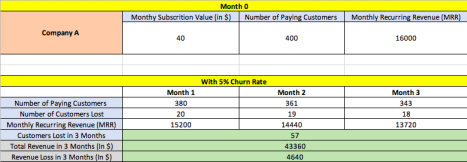 As we can see, at 5% churn rate, Company A would lose 57 customers and $4,640 in revenue over three months. In comparison, below is the table for Company B:
As we can see, at 5% churn rate, Company A would lose 57 customers and $4,640 in revenue over three months. In comparison, below is the table for Company B: 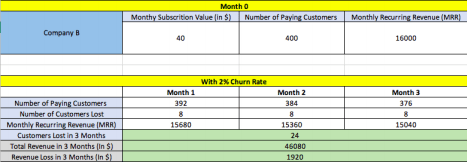 Over three months Company B loses 24 customers and $1,920 in revenue. This simple example demonstrates how Company A loses 33 customers and a total revenue of $2,720 more than Company B. This gap has the potential to widen even further when we consider other factors like customer acquisition and support. David Skok, in his blog, represents the effect of churn on revenue (at 5%, 2.5%, and -2.5%) over 60 months, with the following graph:
Over three months Company B loses 24 customers and $1,920 in revenue. This simple example demonstrates how Company A loses 33 customers and a total revenue of $2,720 more than Company B. This gap has the potential to widen even further when we consider other factors like customer acquisition and support. David Skok, in his blog, represents the effect of churn on revenue (at 5%, 2.5%, and -2.5%) over 60 months, with the following graph: 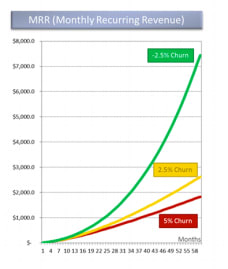 In our example, Company A would need to spend extra on customer acquisition just to keep their revenues at par with Company B. Even if they do so, it would take a massive hit on their resource allocation to other business functions and would deplete the overall customer experience. I sure do hope that now it’s much easier for you to imagine how devastating a higher churn rate can be for a SaaS company. It can seriously impact revenue and has the potential to stagnate growth.
In our example, Company A would need to spend extra on customer acquisition just to keep their revenues at par with Company B. Even if they do so, it would take a massive hit on their resource allocation to other business functions and would deplete the overall customer experience. I sure do hope that now it’s much easier for you to imagine how devastating a higher churn rate can be for a SaaS company. It can seriously impact revenue and has the potential to stagnate growth.
5 Proven Ways To Fight Customer Churn
1. Prioritize Customer Happiness When a customer interacts with your website, he is looking for answers. Period. Whether it’s verifying rental prices, checking out that new collection of sneakers or trying out a tool to automate a process – they’re heading towards making a decision. It’s a decision that solves a pain-point, so should the whole experience that leads to that decision. They should feel happy about choosing you. And it wouldn’t happen if they aren’t happy with the whole experience leading up to that decision. This experience can be measured with NPS or Net Promoter Score. Hubspot defines NPS as:
“It’s a customer satisfaction benchmark that measures how likely your customers are to recommend your business to a friend.”This works on the age old principle that we tend to recommend a service to our friends and family when we’re happy with the experience. And who would want to be held accountable for an irrelevant or less than satisfactory recommendation? Not me. 🙂 On the basis of the their satisfaction level, Neil Patel divides the score in three broad categories:
 The higher the percentage of the detractors, the more important it is look for areas that’s undermining customer satisfaction.
The higher the percentage of the detractors, the more important it is look for areas that’s undermining customer satisfaction.
2. Spruce Up Your User Onboarding
User onboarding is hands down the most critical aspect when fighting churn. It’s the beginning of your relationship with the customer and just like any other relationship, this state is – fragile. First impressions last long, so it better be good. But, if you’re looking for a magic pill to that perfect user onboarding flow, you would be sorely disappointed because there is none. There are some great onboarding flow examples out there but they vary widely in their approach based on the industry and the product category they belong to. One platform might be highly complex and geared towards performing multiple tasks while the other could be designed to perform just one task exceptionally well. Both these platforms would vary in their approach towards their user onboarding, simply because they cater to a vastly different buyer persona. While platforms that nail their onboarding experience might have significant differences in their value proposition; they would always be similar in bringing their customers to their aha moment, asap. Slack, a messaging app for teams, is a great example of a smooth user onboarding flow. It delivers the value proposition with a clean interface and uses its core functionality devoid of any unnecessary distractions. Post this simple setup, Slack takes its customers directly to their channel screen where they are given a guided tour by Slackbot. Quick to value. Don’t be fooled by how simple it looks. This outrageously effective onboarding flow is a result of years of tests and experiments. It means spending countless hours scanning relevant metrics, talking to customers, and conducting numerous A/B tests. 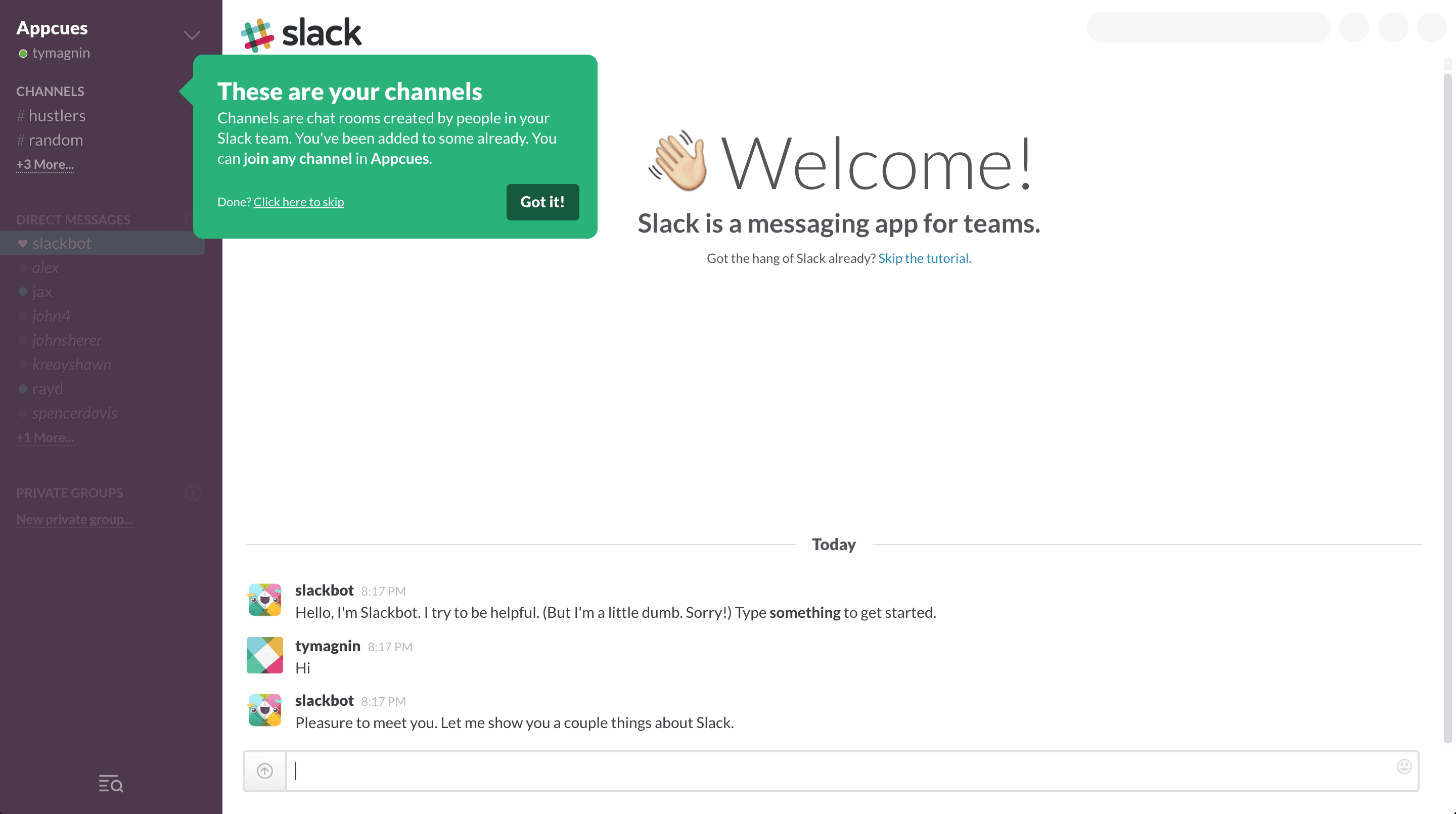 Image Source: reallygoodux.io
Image Source: reallygoodux.io
3. Smoothen Your Customer Experience
When a new user signs up for your product, he has no idea how to go about your product and use it efficiently. It’s for you to hold their hands and help them navigate through the core functions for a smooth user experience. As soon as a user is onboard, the expectations must be clear and instructions, actionable. Even the most technologically savvy users will have areas that they will find difficult to navigate. These bottlenecks in user experience must be identified and mitigated repeatedly to optimize the experience. Grammarly sends this email to everytime a new user signs up- 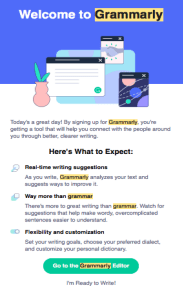 Grammarly sets the expectation right away and guides the user on how to best use the platform. They take the guess out of the way by delivering value right after a user gets on the platform. Towards the end, it gives a clear CTA to drive users to engage with the platform. This makes it incredibly easy for the users to see the value of using Grammarly.
Grammarly sets the expectation right away and guides the user on how to best use the platform. They take the guess out of the way by delivering value right after a user gets on the platform. Towards the end, it gives a clear CTA to drive users to engage with the platform. This makes it incredibly easy for the users to see the value of using Grammarly.
4. Track Activity Churn and Increase Outreach To Boost Customer Engagement
Most companies track cancellations as a measure to calculate churn. But in reality, the decision to churn had been taken before the actual cancellation. This leads to an increasing lack of engagement and eventually causes the customer to churn when he can no longer justify the value of your product. Companies that want to reduce churn must track activity metrics and trigger an outreach sequence that encourages users to re-engage with the platform. Duolingo is often quoted as a prime example of a well-designed user onboarding experience but it goes beyond first impressions. Duolingo encourages a daily learning schedule and sends out its adorable mascot when it detects a fall in engagement. If you’re a Duo user who hasn’t logged in for a while, you might wake up to this sad little bird in your inbox. 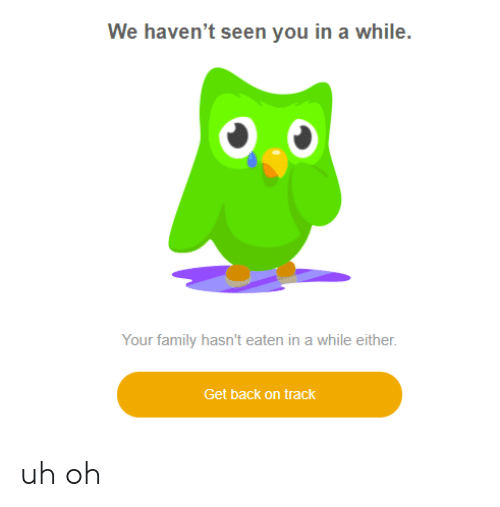 Image Source: me.me With their simple but efficient copy, they tell the user that they are being missed. They also make sure that their nudge isn’t pushy or salesy but emotional. Duolingo uses the right emotional triggers in its re-engagement outreach to relay a story that urges customers to take action.
Image Source: me.me With their simple but efficient copy, they tell the user that they are being missed. They also make sure that their nudge isn’t pushy or salesy but emotional. Duolingo uses the right emotional triggers in its re-engagement outreach to relay a story that urges customers to take action.
5. Encourage Annual Subscriptions
Have you ever signed-up for a monthly gym subscription only to fall out of routine after your first leg day? It happens to the best of us. A SaaS product is no different. While news users take time to imbibe a new product in their day-to-day routine, according to a Localytics study, the chances of a customer leaving your platform are incredibly higher in his first 90 days of signing up. To navigate this problem, SaaS companies focus on annual subscriptions. Consider this example from Ubersuggest. They offer both monthly and annual subscription prices. 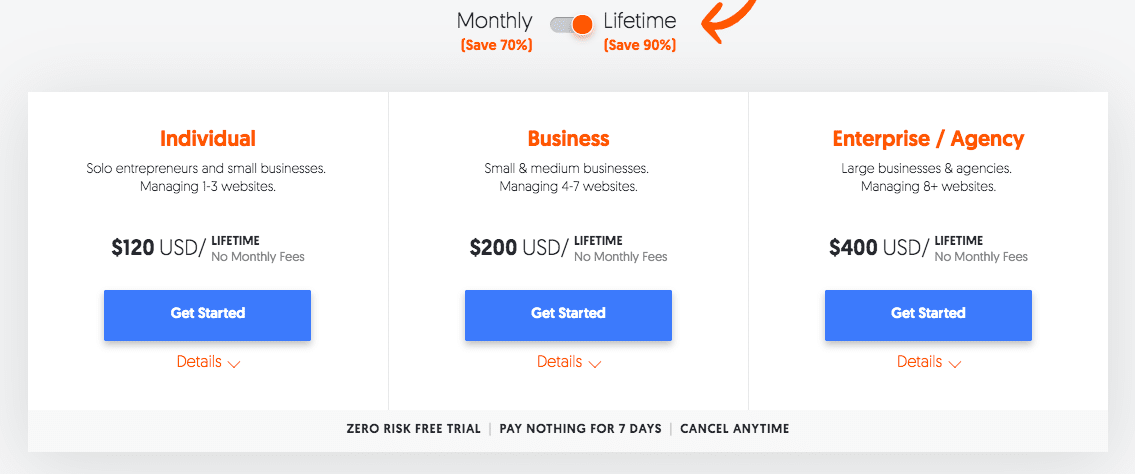
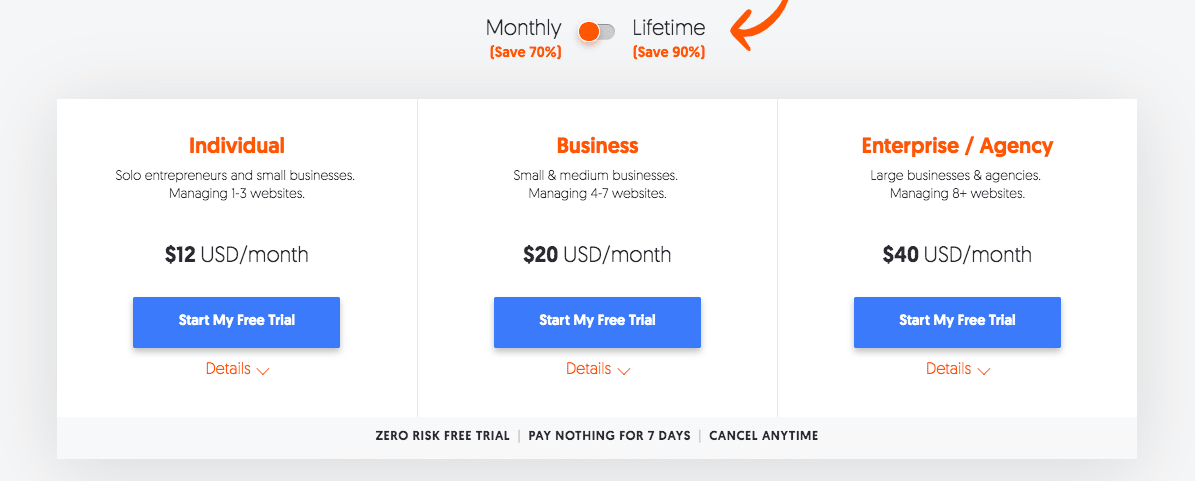 The first image lays out their annual subscription offering and the image below shows monthly pricing. It’s easy for the users to notice the 2 free months they get with the annual subscriptions. And let’s face it. We all love a little dose of ‘Free’ in our lives. That’s always a hell of a deal. For the companies, it means they don’t have to worry about churn for a year. Win-Win.
The first image lays out their annual subscription offering and the image below shows monthly pricing. It’s easy for the users to notice the 2 free months they get with the annual subscriptions. And let’s face it. We all love a little dose of ‘Free’ in our lives. That’s always a hell of a deal. For the companies, it means they don’t have to worry about churn for a year. Win-Win.
Conclusion: The opposite of churn is value, not retention.
Customer churn is something every SaaS company has to face. It’s an undeniable part of the lifecycle of a SaaS. Churn can be utterly frustrating but it isn’t unbeatable. As a SaaS company, you can learn from industry best practices and leaders in your category who have faced similar challenges as yours. But, there is only one golden rule when trying to reduce churn. And it’s that there is none. When trying to reduce churn you do good to focus on two key aspects:- Keep a close eye on every aspect of the customer journey. From sign-up to eventual upsell, identify the bottlenecks in the journey which the customers find difficult to navigate.
- Remove those bottlenecks and exceed value expectations to build a relationship based on trust.
Tags:
SaaS GrowthMay 3, 2021
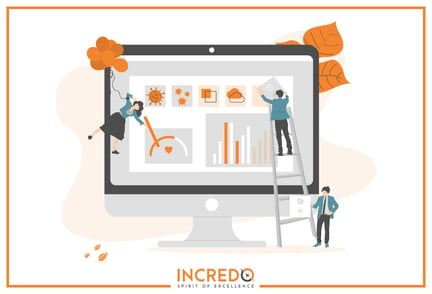

Comments